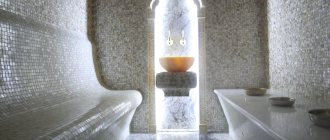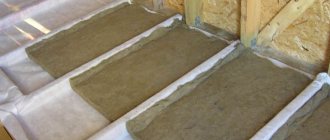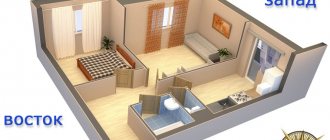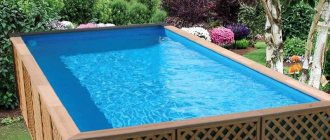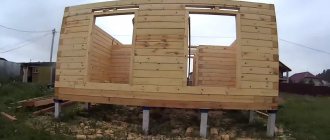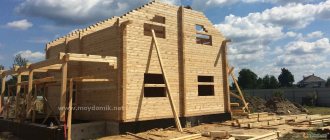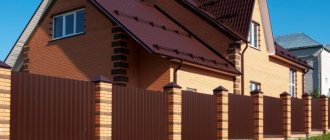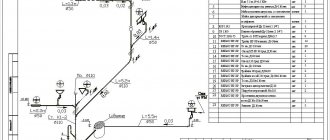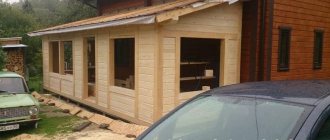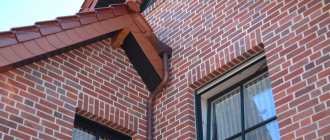The frame of a prefabricated house can be “raised” not only from traditional wooden beams, but also from metal profiles. Thanks to modern technologies, you don’t even need to use a welding machine to connect individual parts. With the help of fasteners, you can build a light steel thin-walled structure from them.
Use of metal frames
Not only private houses on a metal frame are built using light steel thin-walled structures. The construction of buildings with wide spans without additional supports makes it possible to use this technology in the construction of garages, hangars, production workshops, warehouse complexes, shopping pavilions, sports facilities, agricultural buildings for keeping poultry, small and large livestock. Economical prefabricated buildings are characterized by high strength, low weight and mobility.
Recently, practical and convenient stairs on a metal frame have been installed in residential buildings and administrative buildings. Covered with plasterboard, wood or metal-plastic, they have no restrictions when choosing a shape and configuration.
Having experience in construction work, pouring the foundation and assembling a house from a metal frame with your own hands will not be difficult. And the external decoration and decoration of the rooms of a self-built home will bring great pleasure.
The welded frame of a metal building is a durable and strong internal skeleton of the structure. The advantages of such metal frame structures are lightness, strength, relative simplicity, high production and installation rates, mobility and independence from the access road to the installation site, and ease of integration into any space. The metal frame of the building is perfectly compatible with the simplest block and pile foundations, and is also easy to complete, configure and rebuild. The material of the metal frame of the building is profile pipe; angle and channel are less commonly used.
The metal frame of the building includes a lower frame, an upper frame and racks between them. In a metal frame it is very easy to provide doors, openings, windows and metal sheathing for the roof and floor. A frame building made of metal can be sheathed with corrugated sheets, wood, or sandwich panels. The metal frame is very easy and convenient to sheathe and insulate.
Metal frame for a building
Advantages of metal frame buildings:
- Buildings erected using metal frame technology are characterized by low cost (if compared with buildings constructed using traditional technology). The cost of the structure mainly depends on the materials used. The cheapest ones today are houses with wooden frames. The cost of houses with a frame made of profile pipes is much higher, and their price is directly proportional to the cross-section of the pipe. After all, for example, bending a profile pipe is a rather labor-intensive operation and is not cheap.
- High speed of construction of metal frame buildings. Using a profile for the frame as the main material can reduce the construction time of a building several times.
- The absence of so-called “wet” processes in the technology of constructing residential buildings using a frame (except for laying the foundation). This allows installation of frame buildings at any time of the year and regardless of weather conditions.
- Making metal structures with your own hands ensures the absence of any shrinkage - not only during construction, but also during operation of the structure.
Types of structures
How to protect plants from the cold: heating a greenhouse with your own hands
There are countless designs of greenhouses made from metal profiles. Not all of them are suitable for you to build yourself. For example, complex semicircular extensions, greenhouses resembling an igloo - the houses of northern residents, rounded greenhouses require considerable experience, as well as the presence of profiles of the desired shape. Despite the fact that each of them is convenient and has a large amount of usable space, they are only available for purchase in finished form.
Another problem is the simplicity of the design with insufficient functional qualities. For example, greenhouses similar to a dugout, only one meter higher, are very easy to build, but there will be too little space inside, and the gardener will have nowhere to turn around.
In practice, the most common are four types of buildings that you can make with your own hands, and they will be comfortable and fully meet the requirements for illumination and usable space.
According to Mittleider
Greenhouses of this type can be either arched or gable. The difference from ordinary roofs here lies in the location of the slopes: one of them is placed slightly higher than the other, and the remaining gap is adapted for the vents. Thus, according to Mitlider, greenhouses turn out to be the best option in terms of ventilation and air circulation inside.
However, not everything turns out to be so simple. Such a greenhouse cannot be equipped with a removable roof, so it is not suitable for snowy areas. Strengthening the frame here will be much more difficult due to the special design of the roof, so not only will you need careful planning, but also some knowledge of engineering. In a word, if there is such an opportunity, it is best to entrust the design and construction of a greenhouse of this type to professionals or buy a ready-made one. If you are confident in your abilities, you can try to calculate everything yourself.
Single-pitch
Most often, greenhouses with a pitched roof are used as an extension to a garage, house, bathhouse and other good-quality and stable buildings. Such designs are not only simple, but also convenient. There is a lot of space in them, in addition, you can save significant money on heating.
There are a number of specific requirements that are inherent in lean-to structures, and the first of them is its location relative to the main building
It is important that the greenhouse is not in the shade, otherwise it will not be possible to grow light-loving plants in it. This means that you will have to give up the lion’s share of the usual crops: cucumbers, tomatoes, bell peppers, onions, fruits - grapes, strawberries and others
The optimal location of the adjacent greenhouse is on the south side of the facade.
Gable
Gable detached greenhouse houses can be found in many private areas. This is because they often fit perfectly into the surrounding space due to their classic appearance. This especially applies to those situations when the house itself is also equipped with a gable roof.
Such greenhouses have many advantages. Firstly, they can be strengthened and equipped with a removable roof. The second option will not be needed if the greenhouse has high slopes: the snow will simply slide off them. Secondly, building such a greenhouse is easy due to the fact that it has an intuitive structure. You can draw up a drawing yourself, without prior preparation. Thirdly, the greenhouse itself is spacious inside. Even in a small area you can fit a maximum of crops.
Arched
The arched type is the most common of all, and arches can be erected either from straight parts of the profile or using a special arched element. The difference will only be noticeable up close.
Arched greenhouses have all the same positive properties as gable greenhouses, but you still have to deal with the fact that they can sag under the weight of snow - no high slope will save them.
Whatever type of construction you choose, remember that the key to their long service is high-quality materials and proper installation. Only in this case will the greenhouse made of metal profiles be strong enough. Otherwise, no matter how hard you try, the entire structure will quickly become unusable due to some minor flaws.
What is a metal frame house made of?
The main element of LSTK is a thin-walled galvanized profile
, solid or perforated.
When properly calculated, a frame made of thin metal profiles becomes a reliable supporting structure. The galvanized profile does not oxidize, does not deform, or rot
.
The floor of any floor can withstand a load of up to 1000 kg. This indicator is comparable to the load-bearing capacity of a reinforced concrete slab. Layers of insulation dampen sound waves and vibration.
Some profiles are perforated to reduce heat transfer and avoid “cold bridges”
, do not allow the heat to escape. The thickness of the profile offered by the market ranges from 0.75-3 mm.
The frame made of profiles is insulated, the outside is laid with two layers of gypsum fiber, after which the outer cladding is attached.
The outside of metal frame buildings is finished with:
- siding, metal or vinyl;
- OSB, DSP boards, followed by finishing with plaster;
- metal profiled sheet;
- brickwork.
A vapor barrier film is laid on the side of the room and covered with interior finishing material. An air gap is left between the film and the fence
.
As a rule, gypsum plasterboard sheets are used for the inner surface of the wall, finishing with plasterboard sheets as desired.
For insulation, only non-flammable materials are used - mineral wool, extruded polystyrene foam
.
Wall and frame elements are assembled on mechanized assembly tables and delivered to the construction site in large-sized parts or individual posts, adjusted to the millimeter.
The thickness of the walls depends on the climatic region, varies between 150-300 mm
, the number of storeys is limited to six.
Interior work
At first, SkyTiger tried to lay pieces of MDVP between the joists, but since it was 12 mm thick, after laying the insulation, that was exactly how much was sticking out outside the joists. And it turned out that the slabs, with a density of 30 kg/m³, did not want to shrink, so we had to redo everything and completely line the bottom with slab insulation.
Cross insulation of walls - it’s not so easy to push slabs into the LSTK profile, but the eyes were afraid, but the hands did it.
It was planned to cover the walls with 12 mm OSB, but almost all of the material went under the PVC membrane, but there was a lot of nine left. It was used to partially cover those walls in the entrance area on which no hanging furniture was planned in the future. The winter has been snowier than the previous one, but snow is still not a problem.
Ceiling insulation.
The arrangement continued in the summer - further cladding of the walls with 12 mm OSB, for rigidity and the ceiling with 9 mm OSB. All rooms will be given this look before further finishing (vapor barrier, gypsum board, paint).
Proposed bedroom design
Panoramic doors were installed to access the future veranda.
At the same time, we made a wicket and a gate - due to the lack of welding skills, all connections were made using hardware. Custom corner, hinges on M8 screws. The cladding boards were painted the color of ebony, which is also planned for the façade.
And a front fence made of metal profiles, and a gate with a wicket, “temporary buildings”, to protect the site from neighbors’ dogs and to protect neighbors and their dogs from their own dog. All this is planned to be changed to something more presentable in the future.
Frame assembly
Parts manufactured at the factory with extreme precision are marked in accordance with the “skeleton” assembly diagram. The construction of a house from a metal frame is facilitated by the fact that each element and hole strictly corresponds to the approved project. To assemble a durable building frame, you don’t need any special skills or complex tools: you don’t need to measure, cut, or adjust anything.
Low-rise private metal-frame houses are usually assembled by a team of 3-5 people. Transverse frames are assembled using bolted connections from vertical posts and horizontal crossbars, which are installed on the foundation. The design strength of the structure is given by ties and braces attached to the frames. Then the wall and roof purlins, frames for doors and windows are installed. The assembled supporting frame is filled with insulation and lined.
The cost of 1 m2 in a multi-storey metal frame building is reduced by approximately 20-30%, and the speed of construction of a residential building is 3 times faster. The construction of houses made of metal frames with high heat-saving indicators makes it possible to use economical LGST technology in the cold regions of the Far North.
Installation steps: how to attach a profile to a wall for drywall
Before installing the sheathing, the surface of the walls is first prepared. It is not necessary to perfectly level the walls with putty, but it is worth getting rid of the remnants of the old finish and crumbling plaster. If there is little damage, it is enough to simply cover the holes with starting putty, but in the case of plaster falling off in layers, it must be completely knocked off.
Drawing up a drawing
First you need to measure the length and height of the sheathed wall. By adding these values and multiplying by 2, we get the perimeter of the surface. If there are window or door openings on the wall, you also need to measure their perimeter and apply it to the project you are drawing up. When drawing up a drawing, you should immediately take into account the mounting locations for hanging furniture elements, if any.
Tool preparation
Before you begin, prepare the necessary tools.
Namely:
- Hammer;
- Screwdriver;
- Construction level and plumb line;
- Hammer or mallet;
- Yardstick;
- Hacksaw or jigsaw (in the case of wooden frames);
- Grinder or metal scissors (for cutting metal profiles);
- Construction or simple pencil (you can use a marker);
- Fasteners (dowels, screws, crocodile brackets and rods).
The fastening elements for a wooden frame and a metal one are significantly different. The metal profile is fastened with brackets, and the wooden beam with self-tapping screws.
When the tool is ready, you can begin installing the frame. Let's consider both options in detail.
Installation of metal sheathing
If there is a need, first a drawing of the future structure is transferred to the wall, observing the scale and clear vertical/horizontal lines (for this there is a building level and a suspension, or a laser level, which immediately gives a clear vertical, horizontal and, if necessary, diagonal).
Installation step by step:
- Installation begins with attaching guides along the perimeter of the surface, taking into account door and window openings (if any). The distance from the wall is determined according to its unevenness.
- Vertical posts are inserted into the guides and attached to the wall using brackets, dowels and self-tapping screws. The optimal mounting step is 60 cm. Each rack is attached to the wall in three places (at least).
- If the wall is planned to be insulated before covering, mineral wool or other insulation is laid between the profile.
Installation of wooden sheathing
The wooden frame for gypsum boards is installed according to a principle similar to the instructions described above. 70x40 mm timber is used as guides, and 50x30 mm slats are used for racks. The material is attached to the wall using dowels, step 50 - 60 cm. In the case of wall insulation, mineral wool, foam plastic or other selected material is fixed between the studs.
Construction of a metal frame for the construction of a garage
When creating metal structures using your own hands, you need to take into account that this structure must be very rigid, durable and stable. The material for the frame can be a large section corner. It is better to fasten the frame elements by welding, but you can also use a nut-and-bolt connection by drilling holes for fasteners with a hammer drill.
The assembly of the metal frame must be carried out on the construction site. First, the lower frame is mounted, which is attached at the corners to the pins protruding from the foundation - this ensures its immobility. Then corner posts are installed, connected at the top by ceiling purlins.
Vertical posts are installed along the back and side walls of the metal structure made by hand, which will ensure the rigidity of the structure and will serve as lathing for installing wall cladding. There should be a distance between the racks equal to the width of the sheathing sheet, or be slightly less by 3-5 cm if installation with overlap is provided.
The cost of building a turnkey house from light steel thin-walled structures includes a budget for the frame, a set of finishing and other materials, as well as a fee for installation work. This technology is characterized by short implementation times, as well as a favorable price for finished projects.
Advantages and disadvantages
Any private house based on a metal frame has the following undeniable advantages:
- the total weight of the mounted structures is much less than that of a brick or log building of the same area and volume. A lower load allows for a cheaper foundation;
- the house is actually manufactured in a factory where metal elements are cut to the required length. At the site you just need to assemble it according to the instructions. Two to four people can handle this;
- speed of construction. In a few weeks, you can not only assemble the frame, but also form a wall pie, cover the roof and sheathe the outside of the walls.
Construction using LSTK frame technology has one significant drawback - this is the requirement for private developers to strictly comply with all construction algorithms.
Also, metal frames need a large number of stiffeners to withstand the same wind loads.
The wall metal profile fully meets the requirements of SNiP from a safety point of view.
However, many believe that houses with an entirely wooden frame are more environmentally friendly, although a noticeable difference is observed only in sound insulation, since metal is more permeable to all kinds of vibrations.
Simple foundation of a frame house
Metal frame houses
Metal frame construction has been used in construction before. This construction method was used in the construction of industrial buildings: workshops, farms, greenhouses, warehouses and hangars.
After modernization of technology, frames made of profile pipes are used for the construction of public and commercial buildings (cafes, shops, gas stations), cottages and low-rise residential buildings. Technologies are used in the reconstruction and repair of buildings - the construction of wings and attics, the addition of floors.
Advantages of frame construction
The whole world uses metal frame technology in construction. In the USA, Western Europe and Japan, 70% of residential buildings were built using this method. The technology has enough advantages to make it your choice when planning to build your own home.
Minimum labor costs are the main advantage of metal frame construction
- The first advantage of building a frame house from a profile pipe with your own hands is its low cost. Traditional technologies are more expensive. The price of the structure will directly depend on the materials you are going to use. The cost of the frame depends on the cross-section of the pipes, and the cross-section is selected depending on the scale of the construction. For example, if you need to assemble a staircase frame from a profile pipe (section 60x40 mm), the material will be cheaper than for the frame of a house, where the cross-section is much larger. Also, one-story houses are built from smaller diameter pipes than two-story houses.
- The next plus is speed. The use of profile pipes as a frame will reduce the construction time of the building several times.
- Frame technology does not provide for “wet” processes, so weather conditions do not affect construction. The exception is laying the foundation. But often the base is assembled without a foundation. For example, if you are building the frame of a greenhouse or temporary shed from a profile pipe.
- There is no shrinkage in buildings constructed using frame technology. During construction and operation, the building does not change its shape and does not crack. This is another plus.
The main advantage is lower labor costs compared to traditional technologies. To build a house, you only need a couple of helpers and a month's vacation. During this time, you will have time to complete the main stages of construction and leave the interior work until your next vacation. A garage frame made from a profile pipe can be built with your own hands in a week.
Disadvantages of metal frame houses
When starting construction, weigh the pros and cons of frame buildings. The technology has many advantages, but there are also disadvantages. The main disadvantage is the complex design. Calculating the load on a profile pipe in frame nodes is not as simple as it seems at first glance. If you can't do this yourself, contact a professional. It will help calculate the permissible load per meter of pipe. When choosing the cross-section and thickness of a pipe, use the online profile pipe calculator.
Another disadvantage is the cost. Compared to wooden beams, metal material is more expensive. When purchasing pipes, people are faced with the problem of choosing: buy cheaper and save money, or choose a thicker pipe and ensure durability for many years. Here everyone judges based on their budget, but it’s better not to save money. Especially if this is a house, and not a frame for a garage made of a profile pipe.
It is difficult to insulate such houses - this is also a minus. Problems with thermal insulation arise because the metal frame allows cold to enter the building. In such rooms the air quickly cools down, even despite intense heating. Therefore, the building must be insulated efficiently: inside and out. This means you will have to spend extra money.
The metal frame facilitates the entry of cold into the building
Why galvanized polycarbonate greenhouses are better
If you decide to make a greenhouse cover from sheets or cellular polycarbonate, it is always better to choose a galvanized frame.
Basically, cold galvanized products such as:
- Galvanized profile pipe;
- Equally strong open profile made of steel;
- Galvanized steel corner.
Painted steel pipe and profile can also be used.
Since it is easier and more convenient to use galvanized products, we are not talking about painted steel.
Assembling the frame involves treating all connections and fastenings with cold zinc. The special composition is available in spray and liquid form. After making the frame, a second treatment is carried out on problem areas of the structure. Then you can lay polycarbonate.
The procedure for assembling an iron frame, features
Rolled waterproofing in two layers is laid on the mastic over the finished foundation. Installation of a LSTC frame house occurs in the following sequence:
- laying the lower binding profile;
- installation of wall studs, from the corner, controlling the verticality of the elements;
- installation of intermediate racks;
- overlapping fastening of the upper guide profiles;
- construction of a rafter system;
- laying electrical wiring and utility networks;
- installation of facing materials with parallel insulation.
The strapping profile is attached to the foundation with anchors, the remaining joints are connected with self-tapping screws.
Special requirements are imposed on the electrical safety of the building.
. Wiring and disassembly points are carried out in strict accordance with the project. The rules for making connections, the grounding circuit, the power of automatic fuses and their number are strictly observed.
Important! The roof circuit must be grounded and a lightning rod installed
Types of steel profiles
For the manufacture of elements of lightweight thin-walled steel structures, durable structural steel is used. The product itself is made using the cold stamping method. To protect against corrosion, a zinc coating is applied to the metal sheet.
Metal structures are also made from hot-dip galvanized sheets. They are used less frequently due to their high cost, but are much more durable in use.
To produce the profile, a sheet of steel from 0.7 to 2 mm is taken. The choice of thickness is influenced by the required load-bearing capacity of the structural element.
The following types of profiles are used:
- guides,
- rack-mounted,
- hats
Types and types of profiles for constructing a house frame Source nastroike.com
Special beams are also used to cover the floor and shelf. The rafter system of the building consists of the same elements. All elements of the metal frame structure are connected using bolts, rivets, and self-tapping screws. In some cases, resistance welding is used.
Construction cost
MANUFACTURE AND INSTALLATION OF METAL STRUCTURES
- Manufacturing of metal structures from RUB 50,000/t
- Manufacturing of a metal building frame from RUB 2,100/m2
- Installation of the building frame from RUB 12,500/ton
CONSTRUCTION OF RAPIDLY CONSTRUCTED BUILDINGS ON TURNKEY
Manufacturing, delivery and installation of a complete building set including foundation work from RUB 6,700/m2
MONOLITHIC WORKS
- Floor slab (Concrete class B20 / Reinforcement 40kg/m3) 10,000 rub./m3
- Walls (Concrete class B25 / Reinforcement 80kg/m3) 17,000 rub./m3
- Columns (Concrete class B25 / Reinforcement 120 kg/m3) 20,000 rub./m 3
- Floor slabs (Concrete class B25 / Reinforcement 120 kg/m3) 17,000 rub./m 3
CONSTRUCTION OF RESIDENTIAL HOUSES AND COMMERCIAL BUILDINGS FROM FOAM BLOCKS ON A TURNKEY basis
Turnkey construction of residential buildings and commercial buildings with foam blocks starting from RUB 20,000/m2
DESIGN AND SURVEY
- Draft design from 600 rub./m2
- Design documentation for construction from 700 rub./m2
- Project documentation for reconstruction from 600 rub./m2
- Inspection of building structures with a conclusion from 900 rubles/m2
optimal location and linear configuration of metal frame construction
The facility is located away from the noise of the city and highways. The nearest neighbors and the country road are hundreds of meters away - the windows offer views of natural landscapes in any direction. The architects chose to make the metal frame house as open as possible, without hiding the landscapes behind the fence. In one direction there is a panorama of the lake, in the other - of the garden.
At the same time, the site is localized from views from nearby areas with the help of green spaces - trees, shrubs. And modern security systems make it protected even in open conditions.
The linear configuration provides direct access to the local area from any room in the building. There is a close connection between the external and internal space, a smooth transition between them.
Development of a metal frame house project
Typical projects based on LSTC technology have been standardized; all that remains is to choose the best option with the required climatic characteristics.
An individual house project is carried out by the manufacturer
. The first stage will be the creation of technical specifications for the project. The technical specifications determine the desired size of the building in the axes, number of storeys, layout features, main and finishing materials of the building.
In places where wall-mounted furniture and hanging cabinets are attached, reinforcement of the wall rigidity with additional profiles is provided in advance.
On average, calculation of a private house project takes 2-5 working days
. Miscalculations, errors, disproportionality, inconsistency of parts must be eliminated in a factory manner. Sometimes on forums the characteristic clicking sound of the frame when heated is discussed.
note
Profile cracking in the sun is possible only due to errors in installation, trimming of the profile, or installation of additional holes.
Properly mounted, unmodified profiles do not produce sounds.
Galvanized greenhouse frames in Moscow
“Order in one click” is available on the seller’s website. To go to the site, click “Go to store”
“Order in one click” is available on the seller’s website. To go to the site, click “Go to store”
An “Online consultant” is available on the seller’s website. To go to the site, click “Go to store”
“Order in one click” is available on the seller’s website. To go to the site, click “Go to store”
A toll-free number 8-800 is available on the seller’s website. To go to the website, click “Go to store”
A toll-free number 8-800 is available on the seller’s website. To go to the website, click “Go to store”
A toll-free number 8-800 is available on the seller’s website. To go to the website, click “Go to store”
An “Online consultant” is available on the seller’s website. To go to the site, click “Go to store”
“Order in one click” is available on the seller’s website. To go to the site, click “Go to store”
An “Online consultant” is available on the seller’s website. To go to the site, click “Go to store”
An “Online consultant” is available on the seller’s website. To go to the site, click “Go to store”
“Order in one click” is available on the seller’s website. To go to the site, click “Go to store”
An “Online consultant” is available on the seller’s website. To go to the site, click “Go to store”
“Order in one click” is available on the seller’s website. To go to the site, click “Go to store”
An “Online consultant” is available on the seller’s website. To go to the site, click “Go to store”
“Order in one click” is available on the seller’s website. To go to the site, click “Go to store”
An “Online consultant” is available on the seller’s website. To go to the site, click “Go to store”
An “Online consultant” is available on the seller’s website. To go to the site, click “Go to store”
A toll-free number 8-800 is available on the seller’s website. To go to the website, click “Go to store”
An “Online consultant” is available on the seller’s website. To go to the site, click “Go to store”
A toll-free number 8-800 is available on the seller’s website. To go to the website, click “Go to store”
A toll-free number 8-800 is available on the seller’s website. To go to the website, click “Go to store”
A toll-free number 8-800 is available on the seller’s website. To go to the website, click “Go to store”
A toll-free number 8-800 is available on the seller’s website. To go to the website, click “Go to store”
A toll-free number 8-800 is available on the seller’s website. To go to the website, click “Go to store”
A toll-free number 8-800 is available on the seller’s website. To go to the website, click “Go to store”
A toll-free number 8-800 is available on the seller’s website. To go to the website, click “Go to store”
An “Online consultant” is available on the seller’s website. To go to the site, click “Go to store”
A toll-free number 8-800 is available on the seller’s website. To go to the website, click “Go to store”
“Order in one click” is available on the seller’s website. To go to the site, click “Go to store”
Assembly order
All material comes from the factory packaged in bundles. Each part is marked, the same marking is present on the working drawings. The frame of the LSTK house is assembled like a constructor: everything is already ready, even the holes for the hardware are stamped. Put the parts in place, align the grooves and install the fasteners. A metal frame house is assembled in exactly the same way as from wooden blocks. If we outline the stages briefly, step by step everything looks like this:
- The lower frame is fixed to the finished foundation.
- Corner posts are positioned and secured.
- Intermediate posts, jibs and spacers are installed between them.
- The top trim is installed.
- Floor beams are installed and secured. If there is a second floor, its frame is assembled.
- The ceiling is being installed.
The frame of the steel house is ready. All that remains is insulation and finishing work. One note: no matter how much you want to save money, the sheathing should also be assembled from metal. Identical expansion coefficients are precisely what contributes to the high strength of such structures. This cannot be achieved when connecting metal and wood: the fastenings gradually weaken. This is especially critical in regions with increased seismic activity. But even in calmer regions there is little joy in the rattling finish.
Can you build it yourself?
If we are talking about assembling parts that came from the factory into one design, then it’s easy, but with help. All the work consists of finding the required part and installing it in the place indicated in the drawings. It’s difficult at first, but then you get the hang of it.
If by “building a metal frame house with your own hands” you mean welding it from a profile pipe, then this is an ambiguous matter. If you are planning to build a small country house, then there are no questions: the frame can be installed according to the same principle as a wooden one, and for a one-story building, 80 * 80 mm pipes are enough for the corner posts, and smaller ones can be used for intermediate ones. But the installation step is still dictated by the insulation: the clearance distance should be 58-59 cm (slightly less than the standard width of mineral wool).
Assembled skeleton of a house from a special galvanized profile
The only thing you need to remember: when using a profile pipe, there will definitely be cold bridges. Then the insulation itself will need to be done in several layers, blocking heat leaks, which will solve the problem. One layer is traditionally placed in the spacer between the posts. The cross-section of the profile pipe is far from 200-250 mm, which is necessary for insulating a house in the Moscow region (under mineral wool). Therefore, a transverse sheathing is installed under the missing layers (on one or both sides - decide for yourself). It turns out that the insulation is laid vertically between the racks, and horizontally along the sheathing. There are significantly fewer cold bridges.
On the room side, the insulation is covered with a vapor barrier membrane (it should not allow moisture to enter the insulation). From the street side, a windproof, vapor-permeable membrane with waterproofing properties is fixed to it. It performs three functions at once:
- protects from the wind,
- prevents condensation or sediment from accidentally getting into the insulation,
- removes steam from the insulation, which still penetrates there from the room (despite the vapor barrier).
Only with such a cake and the presence of a ventilation gap between the outer membrane and the finishing materials can you be sure that the insulation will not get wet. Only in order for the ventilation gap to work, ventilation holes are also needed at the bottom of the wall and a leak-proof exit under the roof from above: the air flow between the exterior finish of the metal-frame house and the windproof membrane must pass without encountering obstacles.
For inspiration, here’s a video of the process of welding a country house from a profile metal pipe. For those who know how to weld metal, making a metal frame house from a pipe with their own hands is not difficult.
Read about what else you can quickly build a house from here.
METAL MODULAR HOUSE ON A HILL – NO DISCOMFORT IN 35 M² OF LIVING SPACE
Until recently, modular building structures were used exclusively for the construction of trading platforms, trailers, and warehouses. But architects have learned to implement creative, non-standard housing in a prefabricated building. A wooden or metal modular house can be located on any limited area. Bruno Zaitter arquiteto professionals demonstrated all the advantages and possibilities of such a building in the project The Refuge in the Countryside.
diverse possibilities of modular houses
Metal modules are most often chosen for areas with aggressive climates. Wind gusts and precipitation cannot be compensated by the standard construction of an ordinary house. A base made of strong and durable metal protects the interior of the house from possible negative factors, creating a feeling of privacy and security.
In order not to lose touch with the natural environment, the architects made an attractive maneuver by using continuous glazing of the front façade on the north side. The back side is lined with wooden boards. The color scheme of the finishing materials looks harmonious, because the wooden beams have an unnatural greenish tint. Thus, the exterior merges with the landscape, masquerading as the beauty of the surrounding area.
In conditions of strict modulation, the owners of such a shelter do not have many layout options. The corner section houses the bedroom and bathroom, while the central section is reserved for a small kitchen and living room. Thanks to the compact distribution of living space and choice of furniture, residents can move freely around the room.
An additional advantage is the presence of a balcony with wooden flooring. The minimalist design style is maintained inside and outside the building. The black and brown color scheme of the interior smoothly transitions into the exterior in the form of metal railings and natural wood texture. The straight lines of the structure become an allegory to the natural environment, complementing its curved forms and constant intertwining of plants, trees, and hills.
For pragmatic people, modular houses will be a practical choice in building modest housing. Minimal expenditures of time and materials allow you to create a stylish home that stands out among others on a modest budget.
The fact remains indisputable that a metal modular house is a modern, practical, rational solution for organizing living space. Designers are only increasing the popularity of such housing by presenting different interpretations of interior and exterior design.
| Architects | Bruno Zaitter arquiteto |
| Photo | Sergio Mendonça Jr. |
Required tools and materials
Profile pipes, as the main building material, can be purchased from trade organizations or ordered at the factory. The quantity is determined when calculating with a 10% margin. To erect the load-bearing parts of the structure, buy a square profile with a cross-section of 100×100 mm or 60×60 mm.
The toolkit includes:
- Electric welding machine.
- Screwdriver.
- Angle grinder.
- Ladder.
- Shovel and container for applying the solution.
- Tape measure, square, tap and other accessories for measuring operations.
- Consumables: bolts, nuts, screws, etc.
Disadvantages of a metal profile frame
The base of metal parts has several disadvantages.
- In the event of a fire, the galvanized iron base loses its rigidity, the building twists in a spiral, it falls and warps. This feature reduces the evacuation time for residents. A wooden beam, as opposed to iron, becomes charred under the influence of fire, but maintains its shape.
- Difficulty in installing built-in furniture and household appliances. To solve the problem, at the design stage, houses are determined with their installation locations, which are reinforced with additional profiles and wooden panels.
- Limited number of storeys in the house and the impossibility of using heavy building materials.
- High conductivity of electric current with metal frame. Protection against this problem is the potential balancing system.
